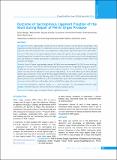Please use this identifier to cite or link to this item:
https://hdl.handle.net/20.500.14356/1563| Title: | Outcome of Sacrospinous Ligament Fixation of the Vault during Repair of Pelvic Organ Prolapse |
| Authors: | Dangal, Ganesh Poudel, Rekha Shrestha, Ranjana Karki, Aruna Pradhan, Hema Kumari Bhattachan, Kabin Bajracharya, Nishma |
| Citation: | DangalG., PoudelR., ShresthaR., KarkiA., PradhanH. K., BhattachanK., & BajracharyaN. (2018). Outcome of Sacrospinous Ligament Fixation of the Vault during Repair of Pelvic Organ Prolapse. Journal of Nepal Health Research Council, 16(3), 321-324. https://doi.org/10.33314/jnhrc.v16i3.1482 |
| Issue Date: | 2018 |
| Publisher: | Nepal Health Research Council |
| Article Type: | Original Article |
| Keywords: | Prolapse Repair Sacrospinous fixation Vaginal hysterectomy |
| Series/Report no.: | Jul-Sep 2018;1482 |
| Abstract: | Abstract Background: Pelvic organ prolapse includes descent of anterior/ posterior wall and apical (vault) prolapse with significant morbidity. In this study we evaluated the outcome of sacrospinous ligament fixation of vault through vaginal approach as part of the repair for massive uterovaginal (pelvic organ prolapse stage III and stage IV) and vault prolapse. Methods: This study on sacrospinous ligament fixation along with repair for pelvic organ prolapse at Kathmandu Model Hospital from November 2016 to April 2018 was done to assess the outcome in terms of early (during hospital stay) and delayed (six months) post-operative complications, need of removal of sacrospinous fixation suture and recurrence of prolapse. Results: Out of 95 pelvic organ prolapse patients, 80 (84%) were post-menopausal, 28 (29.4%) were in the age group of 70-79 years. There were 61 (64%) POPQ stage III. The post-operative complications during post-operative hospital stay were pain over right buttock in 42 (44%), urinary retention in 7 (7%) and UTI in 7 (7%). Sacrospinous suture was released in two patients for severe pain over right buttock. At one-week follow-up, 35 (36%) had right buttock pain of moderate severity and 8 (8%) had vaginal cuff infection. Sacrospinous suture was removed in one patient for neuropraxia two weeks following surgery. At four weeks follow-up, 25 (26%) patients had mild right buttock pain relieved by oral NSAIDs on need. At six months follow-up, five had occasional buttock pain, six had some recurrences and two had some vault prolapse and one each had short vagina and stress incontinence. Conclusions: Sacrospinous ligament fixation is a good procedure for the management of pelvic organ prolapse with better long-term outcome if performed with good surgical expertise. Keywords: Prolapse; repair; sacrospinous fixation; vaginal hysterectomy. |
| Description: | Original Article |
| URI: | http://103.69.126.140:8080/handle/20.500.14356/1563 |
| ISSN: | Print ISSN: 1727-5482; Online ISSN: 1999-6217 |
| Appears in Collections: | Vol. 16 No. 3 Issue 40 Jul - Sep 2018 |
Files in This Item:
| File | Description | Size | Format | |
|---|---|---|---|---|
| 1482-Manuscript-6657-4-10-20190505.pdf | Fulltext Article. | 198.78 kB | Adobe PDF |  View/Open |
Items in DSpace are protected by copyright, with all rights reserved, unless otherwise indicated.
